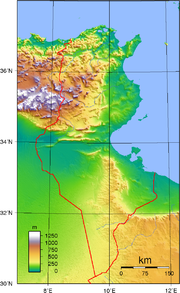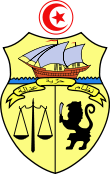History of Tunisia
 |
|||||||
|---|---|---|---|---|---|---|---|
| ANCIENT HISTORY OF TUNISIA | |||||||
| Early History | |||||||
| Berber origins, culture, religion, society, language | |||||||
| Punic Era | |||||||
| Phoenicia, City of Carthage; Berbers; Romans | |||||||
| Roman Era | |||||||
| Berber kings; Africa Province; Vandals; Byzantines | |||||||
| MEDIEVAL HISTORY OF TUNISIA | |||||||
| Early Islamic Era | |||||||
| Ifriqiya: Umayyad, Aghlabid; Berbers; Fatimid | |||||||
| Medieval Era | |||||||
| Berber states: Zirid, Almohad, Hafsid; Ibn Khaldun | |||||||
| Ottoman Era | |||||||
| Pasha & Dey; Muradid, Husaynid; Modern reform | |||||||
| MODERN HISTORY OF TUNISIA | |||||||
| French Era | |||||||
| Protectorate; Independence movement | |||||||
| Modern Era | |||||||
| Republic: Bourghiba, Ben Ali; Society & culture | |||||||
The History of Tunisia is divided into eight articles:
- Early History of Tunisia
- History of Punic era Tunisia
- History of Roman era Tunisia
- History of early Islamic Tunisia
- History of medieval Tunisia
- History of Ottoman era Tunisia
- History of French era Tunisia
- History of modern Tunisia

Contents |
Names
Tunisia, al-Jumhuriyyah at-Tunisiyyah, is a sovereign republic. Since the name of the country has changed several times over the ages, such terms as "ancient Tunisia" are anachronistic and oxymoronic; nonetheless, such are used here for the sake of continuity.
Undoubtedly, ancient Berbers had names for their land and settlements. Then the Phoenician or Punic city of Carthage came to dominate the region and much of the western Mediterranean. All was referred to as Carthage. Next the Romans formed here their Province of Africa, taking the name from the Berber word for the people.[1] The Arabs and Muslims continued to use this name, calling the region Ifriqiya, its capital being the new city of Kairouan. Centuries later Tunis, an ancient but until-then unimportant city, rose to become the region's capital.[2] The whole country then became called by its capital, Tunis. Only in the last years of the nineteenth century, under the French protectorate, did the current name Tunisia come into common use.[3]
History Outline
Its long history may be very briefly outlined or summarized.[4] Here a reverse chronological order is employed. |8| The regimes of the independent government have fostered and steered Tunisian economic development, and navigated the country in the once bipolar now post-cold war world. Tunisia has retained close ties both to Arab coutries and to the West. |7| Earlier the French had incorporated Tunisia into their sphere (1881-1956), preceded by many Italians settlers, merchants and farmers. The modernizing of methods in business and industry was achieved. |6| Before that, Tunisia was under the Ottoman Turks who had seized lasting control from a brief Spanish occupation in 1574. The Turks eventually ruled Tunisia indirectly, through the Muradid and Husaynid Beys. The Ottomans used the Turkish language; with them arrived a multi-ethnic influx. |5| Prior to the Turkish era, the long medieval period had seen a cultural renaissance under the rule of the native Berbers of the region, already Arabized: first the Zirids had established Tunisian independence from the departed Fatimid caliphs now along the Nile; then the Almohad movement succeeded in uniting the entire Maghrib, including Tunisia; the local Hafsid dynasty of Tunis followed, ruling for many centuries during times both prosperous and lean.
|4| The Islamic era had opened with the arrival of the Arabs, who brought their language and the religion of Islam, and its new calendar.[5] Also the Arabs renewed the region's cultural ties with the Semitic east. The Fatimids, a Shi'a state, arose in Ifriqiya, which later conquered and ruled Egypt. |3| During the last pre-Islamic centuries the Byzantines ruled along with Berbrer vassals, and before them the Vandals. Over two thousand years ago the Romans had arrived, initially allied with Berber kingdoms; their cosmopolitan Empire long governed the region as part of an integrated Mediterranean world. |2| Before the Romans, came the Phoenicians, by sea from the eastern Mediterranean about three thousand years ago, and founded here the celebrated ancient city of Carthage. Their Punic culture interacted with the native Berbers, but the two did not then merge. |1| Earlier came migrations from surrounding territories including the Sahel region of Africa. Perhaps eight millennia ago, already there were peoples established here, among whom the proto-Berbers (coming overland generally from the east) mingled and mixed, and from whom the Berbers would spring, during an era of their ethno-genesis.[6][7]

Climate change
Throughout its recorded history the physical features and environment of the land now called Tunisia have remained fairly constant; however, there were differences, e.g., the northern forests during ancient times grew more abundantly, the land being more watered.[8] Earlier in an era of prehistory the Sahara region to the south was not an arid desert, but rather in places grasslands grew with seasonal lakes, and corresponding flora and fauna.[9][10]
Geography
Weather in the far north is temperate, enjoying a Mediterranean climate, with mild rainy winters and hot dry summers, the natural terrain often being wooded, e.g., with cork, oak, and pine. Bizerta on the north coast has a large, developed harbor. The fertile river valley of the Medjerda (Wadi Majardah) (anciently called the Bagradas) flows eastward and empties into the sea north of Tunis. Throughout history the Medjerda and vicinity have been very productive and today remain valuable farmland. Along the eastern sea coast the sahel enjoys a moderate climate, less rainfall but with heavy dew; these coastlands currently support orchards (predominately olive trees) and livestock grazing. The port cities of Hammamet, Sousse, Monastir, Mahdia are here; further south are Sfax, Gabès, and the island of Djerba. Near the mountainous Algerian border to the west rises Jebel ech Chambi, the highest point at 1544 meters. From this area the high tell descends northeastward to the coast, continuing through Cape Bon, south of Tunis. The Dorsale, Tunisia's mountain range, is interrupted by several passes, including the Kasserine.[11] Between sahel and mountain lies the bled, parched plains that are sparsely populated, but where the sacred city of Kairouan is found. In the near south, an east-west belt of salt lakes (called chotts or shatts) cut across the low-lying country, which is called the Djerid. Further south lies the Sahara desert; here Tunisia touches the eastern edge of vast sand dunes comprising the Grand Erg Oriental.[12][13][14]

The present day Republic of Tunisia includes over ten million inhabitants, almost all of Arab-Berber descent. The Mediterranean Sea lies to the north and east, Libya extends to the southeast, and Algeria is west. The capital Tunis has been the principal city in the region for over eight centuries; its population is about 800,000. Located between the mouth of the Medjerda river to the north and Cap Bon, Tunis lies near the ancient site of the city of Carthage.
Reference notes
- ↑ J. A. Ilevbare, Carthage, Rome and the Berbers (University of Ibadan 1981) at 177.
- ↑ The Tunes of the Phoenicians, the Tunesium for the Romans, is the Tunis of today. Graham Petrie, Tunis, Kairouan & Carthage (London: Wm. Heinemann 1908; reprint 2003) at 15.
- ↑ Lisa Anderson, State and Social Transformation in Tunisia and Libya (Princeton University 1987) at 13.
- ↑ Cf., Kenneth J. Perkins, Tunisia. Crossroads of the Islamic and European Worlds (Boulder: Westview & London: Croom Helm 1986); Abdallah Laroui, L'Histoire du Magreb: Un essai de synthèse (Paris: Librairies François Maspero 1970), translated as The History of the Maghrib. An Interpretive Essay (Princeton University 1977); Jamil M. Abun-Nasr, A History of the Maghrib (Cambridge University 1971); Charles-André Julien, Histoire de L'Afrique du Nord (Paris: Payot 1931, 1961) translated as History of North Africa. From the Arab Conquest to 1830 (London: Routledge and Kegan Paul 1970); Jane Soames Nickerson, A Short History of North Africa. Libya, Tunisia, Algeria, Morocco. From pre-Roman days to the present (New York: Devin-Adair 1961); Robert Montagne, La Vie Sociale et la Vie Politique des Berbers (la Société de l'Afrique Française 1931) translated as The Berbers. Their social and political organisation (London: Frank Cass 1973); Michael Brett and Elizabeth Fentress, The Berbers (Oxford: Blackwell 1996); Harold D. Nelson, editor, Tunisia. A country study (Washington, 3d ed. 1988); Kenneth J. Perkins, A History of Modern Tunisia (Cambridge University 2004).
- ↑ The Islamic calendar starts on July 16, 622 A.D., a day estimated for Muhammad's flight (Hijra) from Mecca to Medina. Years in this calendar are designated A.H. for Anno Hegirae, the Hijri year. Since the Islamic calendar is strictly lunar, it runs about eleven and one-quarter days shorter than a solar year; hence calculation of dates between this lunar calendar and a solar calendar are complicated. The calendar used in this article is a solar calendar, the traditional western or the Gregorian calendar, with the years dating from an approximate birth date of Jesus ['Isa in Islam], designated either B.C. for Before Christ, or thereafter A.D. for Anno Domini. Alternatively the western calendar can be renamed to sanction a secular modernism, a nominal neutrality, or otherwise, the years B.C. and A.D. being called B.C.E. and C.E., for Common Era. For prehistory, the kya (thousands of years ago) notation is occasionally employed.
- ↑ Gabriel Camps, Les Berbères (Aix-en-Provence: Edisud 1996) at 11-14.
- ↑ Michael Brett and Elizabeth Fentress, The Berbers (Oxford: Blackwell 1996) at 14-15.
- ↑ Cf., LaVerle Berry and Robert Rinehart, "The Society and Its Environment" at 71-143, 79, in Nelson (editor), Tunisia. A Country Study (Washington, D.C., 3rd ed. 1987).
- ↑ Prior to 6000 years ago, evidently the vast Sahara region to the south was better watered, more a savanna which could support herds; yet then a desiccation process set in, leaving the parched desert it is today. Robert Rinehart, "Historical Setting" at 1-70, 4, in Nelson (editor), Tunisia. A Country Study (Washington, D.C., 3rd ed. 1988).
- ↑ Emile F. Gautier, Le Sahara (Paris: Payot, 2nd ed. 1928), expanded edition translated by Dorothy Ford Mayhew as Sahara. The Great Desert (Columbia Univ. 1935) at 56-61.
- ↑ LaVerle Berry and Robert Rinehart, "The Society and Its Environment" at 71-143, 74-79, map at 75, in Nelson, editor, Tunisia. A country study (Washington, D.C.: American Univ., 3d ed. 1988).
- ↑ Kenneth J. Perkins, Tunisia. Crossroads of the Islamic and European Worlds (Boulder, Colorado: Westview 1986) at 1-5.
- ↑ Jamil M. Abun-Nasr, A History of the Maghrib (Cambridge Univ. 1971) at 1-6.
- ↑ The World Factbook on "Tunisia".
|
|||||||||||